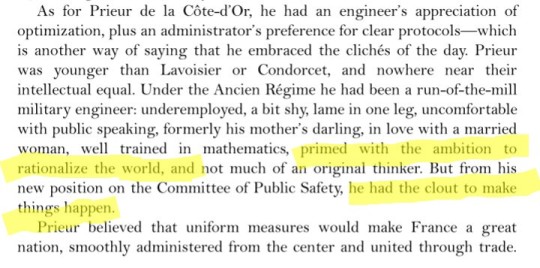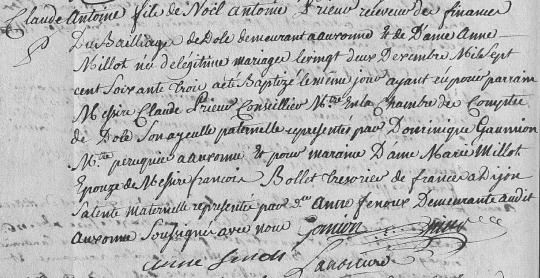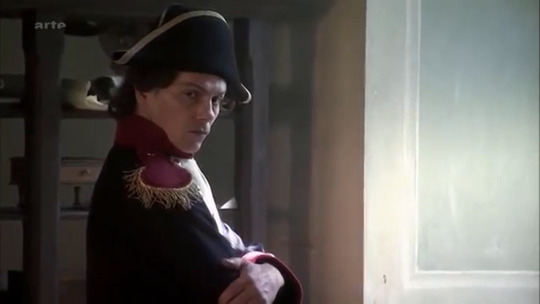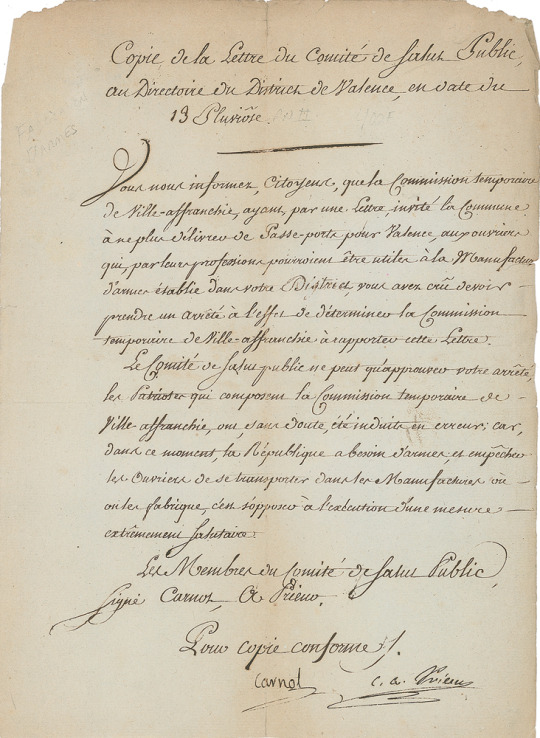#prieur de la cote-d'or
Text

Carnot, Lindet, Prieur de la Côte-d'Or in a fragment of "Panorama de l'Histoire du siècle 1788-1889" by Alfred Stevens and Henri Gervex, Musée des Beaux-Arts de la ville de Paris.
Sources: 1, 2
References for the characters' names from Stevens, Gervex, Reinach "L'Histoire du Siècle", p. 36-37 (note: Prieur is wrongly listed as "de la Marne*)
#lazare carnot#robert lindet#claude antoine prieur#claude antoine prieur duvernois#lindet#prieur de la cote-d'or#frev#french revolution#art#frev art#prieur duvernois
101 notes
·
View notes
Text

Second in the Mapping the CPS series: a map of Ancien Regime France with the places of birth of our notorious third CPS. On the side, you can see a timeline with the date of birth of each of the members.
Some fun facts:
The average age of the Committee of Public Safety in July 1793 was 37, with Lindet being the oldest at 47 and Saint-Just the youngest at 25.
Couthon and Prieur (Cote d'Or) share a birthday on the 22 of December.
Three of the members (Lindet, Robespierre and Carnot) were born in May (so the CPS has 3 birthdays coming up!)
The only deputy of Paris that was actually born in Paris was Collot.
I'm surprised Billaud-Varenne wasn't sent on mission to the West (instead of Prieur de Marne and Saint-André) since he was born in La Rochelle, had family there and lived there until he was 26.
Saint-André shares a birthplace with Olympe de Gouges (a rather small town called Montauban)
Where all the members were born:
Robert Lindet: Bernay
Jean-Marie Collot d'Herbois: Paris
André Jeanbon Saint-André: Montauban
Lazare Carnot: Nolay
Bertrand Barère:Tarbes
Georges Couthon: Orcet
Jacques Billaud-Varenne: La Rochelle
Pierre-Louis Prieur de la Marne: Sommesous
Maximilien Robespierre: Arras
Marie-Jean Hérault de Séchelles: Paris
Claude-Antoine Prieur de la Côte-d’Or: Auxonne
Louis Antoine Saint-Just: Decize
#frev#french revolution#robespierre#committee of public safety#saint just#lindet#collot#saint-andre#lazare carnot#barere#couthon#billaud varenne#prieur#herault
97 notes
·
View notes
Text

An unexpected revelation.
In all honesty, not really that unexpected in itself, but I'm baffled by how easily wrong information can be spread. I've always wondered, indeed, how it was possible for him to be granted or have asked for the title of count given the feeling of "despise" between him and Napoléon.
The excerpt above comes from Gaffarel's biography (p. 349), Bouchard's one doesn't even mention such misunderstanding. According to the former, some of the earliest Prieur's biographers, whose work I happened to find here, stated that he was made comte de l'Empire without quoting a source and looking at the list of people receiving titles during the Napoleonic Era written by Campardon, Prieur's name is in fact missing.
39 notes
·
View notes
Text
Letter from Claude-Antoine Prieur to Louis XVI on the importance of having a unified metric system in France
[The letter is dated April 1790 and included a copy of Prieur's Mémoire sur la nécessité et les moyens de rendre uniformes, dans le royaume, toutes les mesures d'étendue et de pesanteur]
"Sire,
The reputation that your Majesty has gained through his passion for sciences and the protection with which he has constantly provided them inspired in me the desire to offer him a work I have done on the necessity and the means to bring all measures of France to uniformity.
I beg your Majesty to honour me for a moment of his attention, not much for some special merit concerning my work, but above all for the high importance of its content.
It is a great and beautiful idea, the one of giving to a great people a common and invariable measure, and, even better, to make it universal. Today, the difficulties related to the lack of precision in the procedures have been overcome; what is left is just a few prejudices relegated to the classes of ignorant people, of whom the triumphant voice of reason will dismiss the prestige.
France, England, the United States of America have addressed the matter not only in their own countries, but they are in open agreement to achieve an identical result.
Savants are rather convinced of the effectiveness of this operation for the advancement of science; but how much it will reveal itself useful in easing commercial relations, from the simplest exchanges, which people’s daily needs require, to the greatest speculations!
From this double perspective of science and commerce, the States of your Majesty maintain a distinguished position among civilised nations. After all, wisdom, moderation, in a word, all the virtues of your Majesty, suggest on his part an aspiring desire towards the noble glory of being included among the benefactors of humankind. May I be allowed to say that this is a fortunate occasion to add a new benefit to those that your subject already owe you: the reunion of your Majesty with other countries to procure the same measures would be a big improvement and a favourable wish for the happiness of the people; nothing is more appropriate to strengthen in them the bonds of fraternity and concord like the sweet influence of Philosophy.
Respect has set limits that I am not entitled to go beyond. Nevertheless I thought to let truth arrive to the ears of a prince, who, because of his greatness of spirit, has always proven himself worthy of listening. To touch the heart of your Majesty, it is undoubtedly sufficient to mention a useful purpose: it will be even more touched to know that the probity, of which the operation in question is significantly the custodian, will put an end to the activities and tricks of the scoundrels.
I have persuaded myself that my disinterested homages would not be unpleasant; I am, with the utmost respect, your Majesty’s most humble and obedient servant."
— from G. Bouchard, Prieur de la Cote-d'Or, Pièces Annexées, p. 458 - 459
#if you are wondering Louis ghosted him#<- this is why Prieur became a regicide /s#louis xvi#claude antoine prieur#prieur de la cote-d'or#claude antoine prieur duvernois#metric system#prieur duvernois#history of science#frev#my translations
26 notes
·
View notes
Text
Prieur de la Côte-d'Or in a nutshell:

Forgive me, Claude-Antoine >.>
requested by @saintjustitude
The reference:

26 notes
·
View notes
Text
"Summoned by a king who knows no other greatness than the happiness of his people, the representatives of the nation have broken the fetters forged by despotism: feudalism is destroyed, the great work of our regeneration has begun and advances day by day. After having renounced to those privileges, that destroy public prosperity, the provinces want to forget themselves and to blend into the more regular division of departments and districts. These departments, these districts and the smallest portions of the empire will have a similar organisation. The variety of customs, immense source of abuse, will henceforth be replaced by the most exact uniformity in the laws of administration and justice: with such a beautiful order, shall we let the ancient chaos of our measures persist? Is it not about time to remove so many chances of mistakes, frauds and trials?
The present moment is all the more appropriate for a general reform of measures, since the newly adopted principles leave prejudices powerless; and since the people, already disposed towards other more important changes, which have broken their habits, would receive with docility an innovation whose great advantages they could themselves feel."
- Claude-Antoine Prieur-Duvernois, "Mémoire sur la nécessité de rendre uniformes dans le royaume toutes les mesures d'étendue et de pesanteur"
Original in French (modern transcription):
"Appelés près d’un Roi qui ne connaît de grandeur que la félicité de ses peuples, les représentants de la nation ont brisé les fers qu’avait forgé le despotisme : la féodalité est détruite ; le grand œuvre de notre régénération est commencé, et s’avance de jour en jour ; les provinces, après avoir renoncé à des privilèges destructeurs de la prospérité publique, vont s’oublier et se confondre dans la division plus régulière des départements et des districts ; ces départements, ces districts, et les plus petites portions de l’empire, auront une organisation semblable ; la variété des coutumes, source immense d’abus, sera désormais remplacée, dans toute la France, par l’uniformité la plus exacte dans les lois d’administration et de justice : avec un ordre si beau, laissera-t-on subsister l’ancien chaos de nos mesures ? N’est-il pas temps enfin d’ôter tant d’occasions d’erreurs, de fraudes et de procès ? Le moment actuel est d’autant plus convenable à une réforme générale des mesures, que les principes nouvellement adoptés laissent les préjugés sans force ; et que les peuples, déjà disposés par d’autres changements plus importants, qui ont rompu leurs habitudes, recevraient avec docilité une innovation dont ils pourraient eux-mêmes sentier les grands avantages."
#“a king who knows no other greatness than the happiness of his people” LMAO#claude antoine prieur#prieur de la cote-d'or#claude antoine prieur duvernois#metric system#frev#prieur duvernois
15 notes
·
View notes
Text
"De sable à un bâton pastoral d'argent, à la fasce d'azur brochant sur le tout, chargée de deux roses d'or"
It's with these words that Charles D'Hozier describes the family crest of Prieur de la Côte-d'Or, of which is possible to see a picture in the tome Armorial général de France - Généralité de Bourgogne:

Jacques Prieur, the great grandfather of the future member of the National Convention and Committee of Public safety, was employed as a sort of manager and tax collector for the salt warehouse in Chalon-sur-Saône.
Despite belonging to the lowest ranks, Prieur's family was indeed part of the noblesse de robe. However it's important to mention that his father, Noël, was forced in 1767 to sell his "charge de finance" in a vain attempt to repay the debts, his dissolute life was the consequence of.
I'm not sure if one could still be considered a noble if they decided to sell the license that actually gave them access to the nobility though a profession in the juridic or financial field.
14 notes
·
View notes
Text
After having presented the rich and brilliant and fabulous Lavoisier and Condorcet, it's the turn of another stembro:

I... I don't know what to say lmao
Anyway, I couldn't resist not to draw evil clout chaser Prieur, who finally had enough power to rationalize the world!!

He's thinking about what to wear on Lavoisier's execution (ب_ب)
#claude antoine prieur#claude antoine prieur duvernois#prieur de la cote-d'or#frev#metric system#my art#the measure of all things#prieur duvernois#fun
13 notes
·
View notes
Text
Prieur's baptism certificate

—from Archives départementales de la Côte-d'Or, Série E - État civil, notaires et autres officiers publics et ministériels, Registres paroissiaux et état civil, XVIe siècle-1938 (sous-série 2 E)
English translation:
Claude Antoine Prieur, son of Noël Antoine Prieur, tax collector in the bailiwick of Dôle, residing in Auxonne and of dame Anne Millot, born of legitimate marriage on the 22th of December 1763, was baptised on the same day, having as godfather messire Claude Prieur, master counselor at the chamber of accounts of Dôle, his paternal grandfather, represented by Dominique Gomion, master wigmaker in Auxonne, and as godmother dame Marie Millot, wife of messire François Bolet, treasurer of France in Dijon his maternal [great] aunt, represented by demoiselle Anne Fenoux, residing in said Auxonne, undersigned with us.
French original:
Claude Antoine Prieur, fils de Noël Antoine Prieur, receveur des finances du bailliage de Dôle, demeurant à Auxonne et de dame Anne Millot, né de légitime mariage le 22 décembre 1763, a été baptisé le même jour, ayant pour parrain messire Claude Prieur, conseiller-maître en la chambre des comptes de Dôle, son aïeul paternel, représenté par Dominique Gomion, maître perruquier à Auxonne, et pour marraine dame Marie Millot, épouse de messire François Bolet, trésorier de France à Dijon sa [grand] tante maternelle, représentée par demoiselle Anne Fenoux, demeurante audit Auxonne, soussignés avec nous.
Note: I didn't know how to properly translate "messire", "dame" and "demoiselle" in English since "Mr, Mrs" and "Miss" come from the 19th century and using "lady" and "maiden" didn't sound appropriate to me. If someone knows better options let me know!
#curious how both his name and that of his father are written without the hyphen#i wonder if it was added posthumously#prieur de la cote-d'or#claude antoine prieur#prieur duvernois#claude antoine prieur duvernois
13 notes
·
View notes
Text
Considering that Prieur's aunt invented and took the name Duvernois for unknown reasons - she never married - and considering that Prieur himself stopped using that surname after nobility titles were abolished in '91 and addressed himself all the time with his fancy CSP nickname "Prieur de la Côte-d'Or" in his Révelations, I believe it's not appropriate to call him "Prieur-Duvernois".
Digging a bit I discovered that it's the painter Emil Groux, who for this illustration resurrected that name and it happened years after Prieur's death.
#it means I have to change the label of my main prieur tag??#it's more than 50 posts send help#claude antoine prieur#<- this will be the new one for when i'll have the strength to change it >.>#prieur de la cote-d'or#it also means someone has to change his wikipedias pages#not only for the name but for other inaccurate info#<- again i'll personally do this when i finish studying him
7 notes
·
View notes
Text
Prieur on the implementation of the decimal scale in the metric system
The key point, in which Prieur's proposal, aimed to reform the French metric system, differentiates itself from the others, lies in the detailed implementation of the decimal scale for all kind of measures. This is why I thought appropriate to share the following excerpt, taken directly from his work. Its content might sound obvious for many of us, but it's important to remember that, in the 18th century, the scale commonly used in France was the duodecimal one. Prieur was among the scholars of the time to have relised the great advantages that the decimal subdivision would have brought in the fields of calculation and arithmetic, by making the former more straightforward in general and the latter more accessible to everyone, especially to those, who didn't receive an education.
Below, under the cut, I also added the transcribed version by Isabelle Dutailly of Prieur's measures conversion table between the standards used during the Ancien Régime in Paris and the new ones, he proposed to use. It gives a general idea about both the tremendous amount of units present just in the capital and how close Prieur's subdivision of measures is compared to our current one.
"[...]Our pied national will be divided into ten pouches, each pouche in ten lignes, each ligne in ten points or primes, so that it will be possible to write each subspecies [of measure] as decimals of the main unit. This method of division is the most proper that we can accept, since it is in accordance with the rules of our numeration and, if it were applied to all the various kind of measures, the study of arithmetic would become much easier and, as a result, more widely practiced. Someone might say that diving by twelve would be convenient when considering the 1/3, 1/4 and their submultiples: this is undeniable. It is also certain that the duodecimal scale could have been used instead of the decimal one for our numeration, but such a change would currently be impractical . On the other hand, the decimal system reveals itself to be convenient for people, who do not know how to write, since it would allow them to represent each ten through their fingers, therefore each hand would be equal to one half of ten, making the count of five parts easier. The introduction of the decimals in all the measures is beneficial in making calculation easier, in that more complex multiplications and divisions are converted to operations similar to those of whole numbers; in that the reduction of each subspecies, from one to another, happens through the simple shift of the decimal point and finally, in that it would allow to increase or decrease the precision of an operation according to our needs. In the majority of cases relative to calculations of our length measurements, there is no need for this operation to go beyond the thousandth, and often the hundredth too, of the main unit."
— Claude-Antoine Prieur, Mémoire sur la nécessité et les moyens de rendre uniformes, dans le royaume, toutes les mesures d'étendue et de pesanteur (1790), p.15-16.
Note: Emphases in italics are mine, moreover I didn't translate the units into English, because their corresponding value in said language wouldn't match with the French one, so I believed it wasn't wise.
"Table of comparison between the old units of weights and length used in the city of Paris and the new national ones, which are supposed to replace the former"


Source for the original table.Source for the transcribed version.
#claude antoine prieur#prieur de la cote d'or#claude antoine prieur duvernois#metric system#history of science#frev#my posts#prieur duvernois
20 notes
·
View notes
Text
I'm finally watching Un mètre pour mésurer le monde. I'm 6 minutes in and I'm already rolling my eyes.. But surprisingly in a positive way, similar to whenever I watch the Terror BBC Doc.
I'm literally just waiting for this meany to show up again :3

By the way, why would Prieur have wanted to use the Parisian metric unit as standard in 1792 when just one year earlier he had already opted for the Earth meridian arc??
I'm confused.🤨
Also from the very beginning of this doc he's explicitly presented as one of the villains L M A O
#claude antoine prieur#prieur de la cote d'or#prieur duvernois#frev#the holy meter#un mètre pour mésurer le monde
45 notes
·
View notes
Text

First time ever using colors! (...and it shows, ugh)
I added the name because he wasn't recognizable otherwise >.>
#prieur duvernois#claude antoine prieur#prieur de la cote d'or#french revolution#frev#my art#frev art#art
41 notes
·
View notes
Text
"[...] et souvent la crainte de mal faire m'empêche de faire. Je ne me découragerai pas cependant, je veux forcer la nature par un travail opiniâtre."
En:
"[...] and often the fear of doing something poorly prevents me from doing it. I will not get discouraged however. I want to force nature through a tenacious work."
— Prieur de la Côte-d'Or in a letter to Louis Bernard Guyton dated 23 July 1790
#and he did ;_;#this hits me so personally you have no idea#claude antoine prieur#prieur de la côte-d'or#prieur de la cote d'or#quotes
17 notes
·
View notes
Text
Copy of the Letter of the Committee of Public Safety to the Directory of the District of Valence dated 19 Pluviôse [Year II]

Citizens, you inform us that the temporary commission of Ville-Affranchie [Lyons], having exhorted the Commune not to deliver passports to workers anymore, who through their profession could be useful in the weapon manufacture, established in your District, you thought it necessary to issue an order instructing the temporary commission of Ville-Affranchie to return this letter.
The Committee of Public Safety cannot but approve your decree, patriots who compose the temporary commission of Ville-Affranchie, have indubitably been misled; for, at this moment, the Republic needs weapons, and preventing workers to travel to manufactures or factories is to oppose to the execution of an extremely beneficial measure.
Signed Carnot, A. Prieur.
For certified copy s.
Carnot, C.A. Prieur
I wanted to share it not only because it's exclusively signed by Carnot and Prieur, but also I found interesting how the name of the latter is written only with an "A." in the copied version. It's not the first time he's addressed as "Antoine Prieur": the same happens in a document relative to the succession of his father. I wonder if he went by Antoine in reality, instead of Claude, or if it's just a mistake.
Modern transcription of the letter - more like just me trying to decipher the calligraphy than an actual serious transcription - under the cut:
Vous nous informez, citoyens, que la commission temporaire de Ville-affranchie, ayant, par une Lettre invité la Commune à ne plus délivrer de passeports pour Valence, aux ouvriers qui, par leur profession pourraient être utiles à la manufacture d’arme établie dans votre District, vous avez cru devoir prendre un arrêté à l’effet de déterminer la Commission temporaire de Ville-affranchie à rapporter cette lettre.
Le Comité de Salut Public ne peut qu’approuver votre arrêté, les Patriotes qui composent la Commission temporaire de Ville-Affranchie, ont sans doute, été induit en erreur ; car, dans ce moment, la République a besoin d’armes, et empêcher les ouvriers de se transporter dans les manufactures ou les fabriques, c’est s’opposer à l’exécution d’une mesure extrêmement salutaire.
Les membres du Comité de Salut Public.
Signé Carnot, A. Prieur.
Pour copie conforme s.
Carnot, C.A. Prieur
#frev#csp#committee of public safety#lazare carnot#claude antoine prieur#prieur de la cote d'or#my translations#queue
15 notes
·
View notes
Text
Apparently, there's another representation of Prieur, very different from the skinny catty soldier-nerd shown in that documentary on the metric system:

This fancy dude is Luigi Pistilli and, according to the play script that I own, he's starring as Prieur de la Côte-d'Or in the play "The Jacobins" by Federico Zardi, which was staged for the first time on April 14 1957 in Milan.
A peculiar choice that one of making him a seductive dandy, but I can't say I'm disappointed.
#prieur duvernois#prieur de la cote d'or#i giacobini#federico zardi#luigi pistilli#frev#claude antoine prieur
13 notes
·
View notes